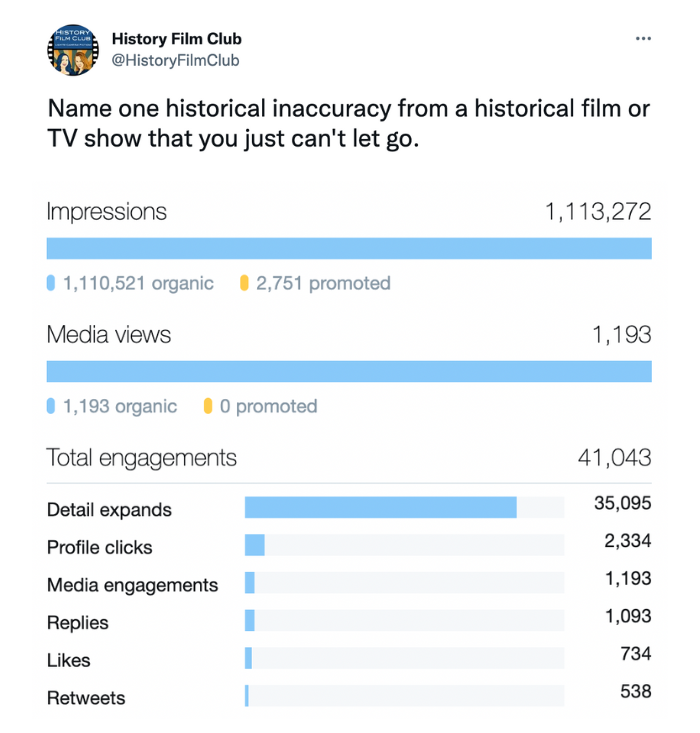I like to believe that things happen for a reason.
Let’s just say that I’ve always found it an empowering state of mind. It’s encouraged me to go for opportunities that, otherwise, I probably wouldn’t have gone for. (This is relevant, I promise.)
So, when I received an email in early 2021, inviting applications to work on social media content for a little-known podcast called History Film Club, I went for it. And got it.
Once the six-week internship ended, they kept me on as their freelance Assistant Producer. Since then, I’ve been working to:
- Grow our online following
- Boost engagement with our social media content.
And, last month, we went viral on Twitter for the first time.

Side note: If you’re a financial adviser/planner who doesn’t host a podcast, consider it. In our recent LinkedIn poll (thanks, Phil), only 11% of respondents reported hosting one.
So, despite 56% confirming that they listen to the likes of The Human Side of Money, Maven Money, and The Meaningful Money Podcast, it’s a largely untapped market.
If I can’t convince you, Nick’s blog on the matter might. Anyway…
For current (and budding) podcast hosts, social media is an exceptionally powerful tool.
Here are four proven ways to grow your podcast audience on social media.
1. Know your audience (and where they hang out)
When I first started working with History Film Club, the content I produced was pretty poor. Apparently, watching every series of Peaky Blinders and one episode of Wolf Hall doesn’t make you an expert in period drama.
Who knew?
As a financial adviser/planner, your current and prospective clients will have particular priorities. For some, it might be mortgages and investing. For others, protection policies and retirement planning. It may well be a combination if you work with a broad range of people.
For your podcast to have any hope of being successful, you need to:
- Understand who your listeners are
- Find out what keeps them up at night
- Solve those pain points with your content.
You also need to know where they hang out online.
In April 2021, History Film Club had around 107 followers on Instagram and 1,589 on Twitter. Despite this, I was convinced Instagram was where we needed to pour the majority of our efforts.
I was happy to be wrong.
After a few months, I realised the reverse was true, and concentrated my time on Twitter. Now, we have 302 followers on Instagram and 3,513 on Twitter. It’s important to be led by your audience’s online habits. Top tip: this is one way a client survey can really help you.
2. Have a plan and be consistent
I post on Twitter every single day for History Film Club, rotating through seven different post types.
- Monday = favourite historical film/TV show as chosen by a guest
- Tuesday = Patreon promotional video
- Wednesday = a question (such as tweet above)
- Thursday = new/upcoming historical film/TV show
- Friday = episode announcement (new or reminder of old)
- Saturday = self-promotional post for our hosts (e.g. a book they’ve written)
- Sunday = general “who we are” post or ask for a review on Apple Podcasts.
And you should be showing up online for your podcast every day too.
Why? Because your audience will forget about you otherwise, especially if you’re using Twitter.
Did you know that the half-life of a tweet (the point at which it has received 50% of all the attention it’s going to get) is a microscopic 24 minutes? Compare this to posts on LinkedIn, for example, which have a half-life of 24 hours. Posting every day might feel like you’re being repetitive, but this isn’t the case.
I don’t know the statistics for every platform but would it help if I told you that only 10-15% of your LinkedIn connections see every post you upload? Odds are that it’s a hell of a lot less for platforms with a smaller half-life, like Twitter.
So, you have to be consistent.
Have a think about what your weekly plan could look like. (Or let us have a think for you.)
The benefits are that:
- It develops a sense of community
- It makes coming up with content a lot easier
- It gives your online presence a sense of familiarity – how can you expect your audience to recognise your brand if you lurch between different types of content week on week?
3. Do not just sell, sell, sell
You might have noticed from the plan that I don’t actively promote our podcast every day.
I ”sell” it twice a week, max, on Fridays and Sundays. The rest of the time, it’s all about adding value.
This is why understanding your audience is so important. People use social media to be educated, entertained, and inspired. “Contact me to discuss your pension plan” is none of those things.
More than that, the focus is on you, not them. There’s an element of selflessness attached to good podcast promotion on social media. You find out what your audience is interested in, and you give it to them.
So, you’ve decided that making the most out of investing is important to your clients/listeners. Of course, if that’s the case, you should be recording episodes about it. Some with you, some with guests, some with current or previous clients. But, when it comes to social media, promoting these episodes will only get you so far.
Other post types could include:
- Regular stock market updates
- An opinion piece on a recent, relevant news article
- A poll asking your audience what they think of investing
- A client testimonial from someone you’ve helped with their financial plan.
So, then, when you promote your podcast episodes on investing, your audience are far more likely to pay attention.
Why? Because you’ve:
- Educated them on a topic that matters
- Positioned yourself as a go-to expert on the subject
- Helped them understand (and, hopefully, relate) to your point of view.
4. Content is king, not money
A small point to finish on.
When I saw the tweet (that I posted at the start of this blog) was gaining some traction, I chucked a bit of money towards promoting it. Not a lot, maybe £20.
I’d done this before with other reasonably successful tweets and, in some cases, it had made a small difference. But, if you go back to the top and look at the analytics, you’ll see what a tiny percentage of the engagement came from that. In hindsight, given that my passion is organic social media marketing, I’m a bit annoyed with myself!
Bill Gates was right when he said that content is king.
And it’s a useful reminder of where your priorities should be when building your online presence.
Give it a go
Even if podcasts aren’t your thing, anyone who uses social media to promote their business (and you should) can take something away from this blog.
And, if you still need more support with your social media strategy, we’re here to help.
Drop us an email at hi@theyardstickagency.co.uk, send us a Loom video (if you really want to impress Phil), or give us a call at 0115 8965 300.


